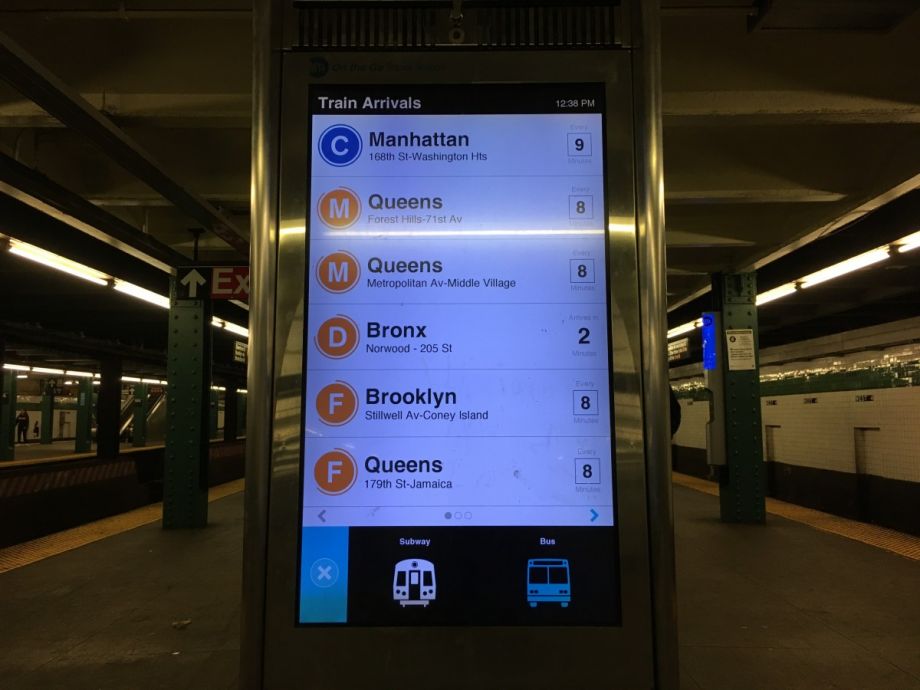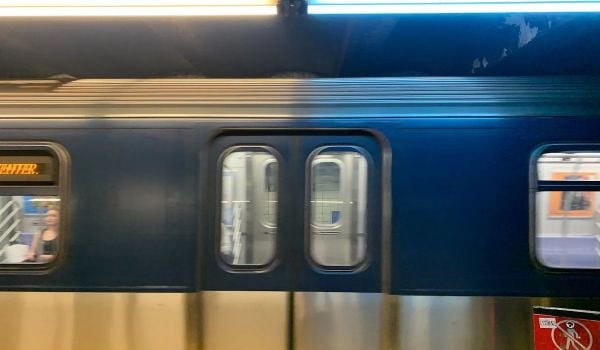The people of New York City live in a strange bubble. There’s around 8.5 million of us, living in around 3 million households, only half of which have a car. It simultaneously means there’s a strong auto repair sector serving some 2 million cars in the city, while 2.1 million workers take public transit to work on a daily basis — and that’s just counting the workers who live in city limits.
Counting everyone, including suburban commuters taking regional rail into the city, tourists, students and more, the most recent official number for average weekday ridership on the NYC subway is 5.6 million. The next two cities by weekday subway/L/metro ridership in the country: Chicago, 631,000, and then D.C., 539,000.
So, within that bubble, how big of a deal is it that NYC subway riders on nearly all the city’s lettered lines — the A, C, E, B, D, F, M, N, Q, R, W, J and Z trains — are finally able to view estimated real-time train arrival information through on-platform displays?
The short answer is, we’ll see. New Yorkers are notoriously creatures of habit, growing deeply attached to their apartments, the bodegas in their neighborhood, their laundromats, and even their commutes. Our places seem to become a part of who New Yorkers are, even physiologically. As one observer wrote in The New Yorker, “Subway nappers are clearly at home: their commute is worn so deeply into them that, typically, their bodies jerk awake before they miss their stops.”
So it’s hard to imagine the extent to which real-time train arrival information displays will somehow stoke changes in New Yorkers’ lives so drastic as to alter where they live or how they get to work. But it doesn’t mean the countdown clocks, as they’re known colloquially, don’t matter.
Those of us (myself included) who have been fortunate to live along and regularly use a numbered subway — the city’s 1, 2, 3, 4, 5, 6 and 7 trains — have had the luxury of countdown clocks since 2006, according to the Riders Alliance, and the L train before that. In an increasingly hectic city, it can be a small bit of peace of mind to know exactly when the next train is pulling into the station, even if the reality is it won’t be for another 10 or 20 minutes. There’s also the safety aspect — depending on the station design or whether train arrival data can be seen before crossing a turnstile, riders can choose to wait in view of a well-lit, 24-hour manned booth instead of spending the whole time on a narrow, relatively darker platform.
There’s also knowing that the Metropolitan Transportation Authority, the state-chartered entity that manages NYC public transit, has finally delivered on a long-held promise to bring countdown clocks to the rest of the lettered lines (the L train’s arrived in 2004). “AT LAST,” exclaimed WNYC, the local public radio station. (The lettered and numbered subways were built by different companies, to different specifications, so that the trains, tracks and platforms of each are not compatible.)
It is among a number of old promises on which MTA has finally made good. Underground cellular service, first installed at four stations in 2011, was only just expanded to all underground stations earlier this year, Wired reported. The lack of underground cellular service on subway platforms in the country’s most economically important city had long passed the point of comical. DC’s Metro has had cellular service available for major carriers on its platforms for several years at this point, as far back as 2009 for its busiest stations. NYC’s West 4th Street Station, a key transfer point where seven lines converge, had no underground cellular service until earlier this year.
Rider advocate groups like Riders Alliance, Straphangers Campaign and others have been asking for countdown clocks for years across all the lines. But most riders would probably give up the countdown clocks in exchange for fewer delays and more frequent service. The displays certainly aren’t any consolation for Governor Andrew Cuomo’s slashing $65 million from the MTA budget.
But at least more people will know how late they’ll be running due to those budget cuts.

Oscar is Next City's senior economic justice correspondent. He previously served as Next City’s editor from 2018-2019, and was a Next City Equitable Cities Fellow from 2015-2016. Since 2011, Oscar has covered community development finance, community banking, impact investing, economic development, housing and more for media outlets such as Shelterforce, B Magazine, Impact Alpha and Fast Company.
Follow Oscar .(JavaScript must be enabled to view this email address)
















